JEEP GRAND CHEROKEE 2023 Owners Manual
Manufacturer: JEEP, Model Year: 2023, Model line: GRAND CHEROKEE, Model: JEEP GRAND CHEROKEE 2023Pages: 424, PDF Size: 15.48 MB
Page 351 of 424
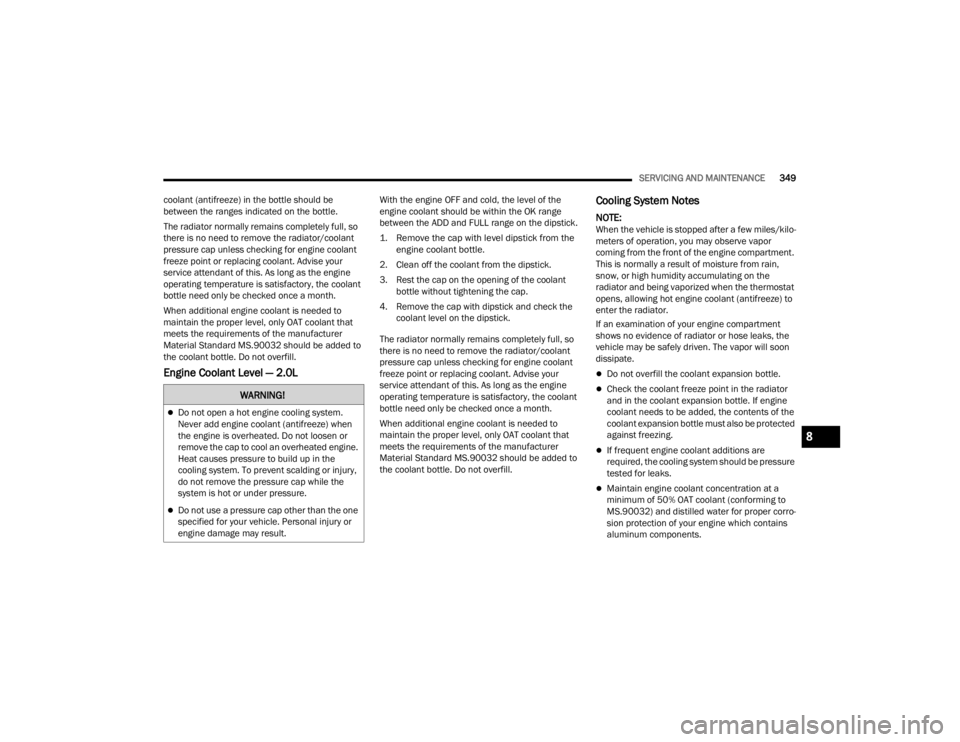
SERVICING AND MAINTENANCE349
coolant (antifreeze) in the bottle should be
between the ranges indicated on the bottle.
The radiator normally remains completely full, so
there is no need to remove the radiator/coolant
pressure cap unless checking for engine coolant
freeze point or replacing coolant. Advise your
service attendant of this. As long as the engine
operating temperature is satisfactory, the coolant
bottle need only be checked once a month.
When additional engine coolant is needed to
maintain the proper level, only OAT coolant that
meets the requirements of the manufacturer
Material Standard MS.90032 should be added to
the coolant bottle. Do not overfill.
Engine Coolant Level — 2.0L
With the engine OFF and cold, the level of the
engine coolant should be within the OK range
between the ADD and FULL range on the dipstick.
1. Remove the cap with level dipstick from the engine coolant bottle.
2. Clean off the coolant from the dipstick.
3. Rest the cap on the opening of the coolant bottle without tightening the cap.
4. Remove the cap with dipstick and check the coolant level on the dipstick.
The radiator normally remains completely full, so
there is no need to remove the radiator/coolant
pressure cap unless checking for engine coolant
freeze point or replacing coolant. Advise your
service attendant of this. As long as the engine
operating temperature is satisfactory, the coolant
bottle need only be checked once a month.
When additional engine coolant is needed to
maintain the proper level, only OAT coolant that
meets the requirements of the manufacturer
Material Standard MS.90032 should be added to
the coolant bottle. Do not overfill.Cooling System Notes
NOTE:When the vehicle is stopped after a few miles/kilo -
meters of operation, you may observe vapor
coming from the front of the engine compartment.
This is normally a result of moisture from rain,
snow, or high humidity accumulating on the
radiator and being vaporized when the thermostat
opens, allowing hot engine coolant (antifreeze) to
enter the radiator.
If an examination of your engine compartment
shows no evidence of radiator or hose leaks, the
vehicle may be safely driven. The vapor will soon
dissipate.
Do not overfill the coolant expansion bottle.
Check the coolant freeze point in the radiator
and in the coolant expansion bottle. If engine
coolant needs to be added, the contents of the
coolant expansion bottle must also be protected
against freezing.
If frequent engine coolant additions are
required, the cooling system should be pressure
tested for leaks.
Maintain engine coolant concentration at a
minimum of 50% OAT coolant (conforming to
MS.90032) and distilled water for proper corro -
sion protection of your engine which contains
aluminum components.
WARNING!
Do not open a hot engine cooling system.
Never add engine coolant (antifreeze) when
the engine is overheated. Do not loosen or
remove the cap to cool an overheated engine.
Heat causes pressure to build up in the
cooling system. To prevent scalding or injury,
do not remove the pressure cap while the
system is hot or under pressure.
Do not use a pressure cap other than the one
specified for your vehicle. Personal injury or
engine damage may result.
8
23_WL_OM_EN_USC_t.book Page 349
Page 352 of 424
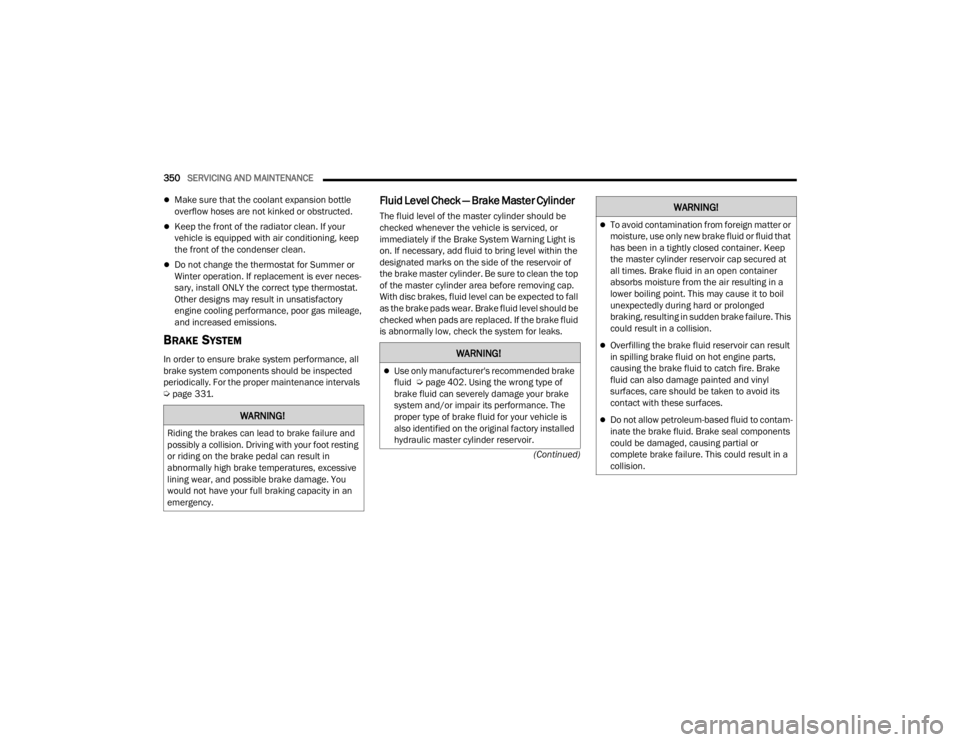
350SERVICING AND MAINTENANCE
(Continued)
Make sure that the coolant expansion bottle
overflow hoses are not kinked or obstructed.
Keep the front of the radiator clean. If your
vehicle is equipped with air conditioning, keep
the front of the condenser clean.
Do not change the thermostat for Summer or
Winter operation. If replacement is ever neces-
sary, install ONLY the correct type thermostat.
Other designs may result in unsatisfactory
engine cooling performance, poor gas mileage,
and increased emissions.
BRAKE SYSTEM
In order to ensure brake system performance, all
brake system components should be inspected
periodically. For the proper maintenance intervals
Ú page 331.
Fluid Level Check — Brake Master Cylinder
The fluid level of the master cylinder should be
checked whenever the vehicle is serviced, or
immediately if the Brake System Warning Light is
on. If necessary, add fluid to bring level within the
designated marks on the side of the reservoir of
the brake master cylinder. Be sure to clean the top
of the master cylinder area before removing cap.
With disc brakes, fluid level can be expected to fall
as the brake pads wear. Brake fluid level should be
checked when pads are replaced. If the brake fluid
is abnormally low, check the system for leaks.
WARNING!
Riding the brakes can lead to brake failure and
possibly a collision. Driving with your foot resting
or riding on the brake pedal can result in
abnormally high brake temperatures, excessive
lining wear, and possible brake damage. You
would not have your full braking capacity in an
emergency.
WARNING!
Use only manufacturer's recommended brake
fluid Ú page 402. Using the wrong type of
brake fluid can severely damage your brake
system and/or impair its performance. The
proper type of brake fluid for your vehicle is
also identified on the original factory installed
hydraulic master cylinder reservoir.
To avoid contamination from foreign matter or
moisture, use only new brake fluid or fluid that
has been in a tightly closed container. Keep
the master cylinder reservoir cap secured at
all times. Brake fluid in an open container
absorbs moisture from the air resulting in a
lower boiling point. This may cause it to boil
unexpectedly during hard or prolonged
braking, resulting in sudden brake failure. This
could result in a collision.
Overfilling the brake fluid reservoir can result
in spilling brake fluid on hot engine parts,
causing the brake fluid to catch fire. Brake
fluid can also damage painted and vinyl
surfaces, care should be taken to avoid its
contact with these surfaces.
Do not allow petroleum-based fluid to contam -
inate the brake fluid. Brake seal components
could be damaged, causing partial or
complete brake failure. This could result in a
collision.
WARNING!
23_WL_OM_EN_USC_t.book Page 350
Page 353 of 424

SERVICING AND MAINTENANCE351
AUTOMATIC TRANSMISSION
Special Additives
The manufacturer strongly recommends against
using any special additives in the transmission.
Automatic Transmission Fluid (ATF) is an
engineered product and its performance may be
impaired by supplemental additives. Therefore, do
not add any fluid additives to the transmission.
Avoid using transmission sealers as they may
adversely affect seals.
Fluid Level Check
The fluid level is preset at the factory and does not
require adjustment under normal operating
conditions. Routine fluid level checks are not
required; therefore the transmission has no
dipstick. An authorized dealer can check your
transmission fluid level using special service tools.
If you notice fluid leakage or transmission
malfunction, visit an authorized dealer
immediately to have the transmission fluid level
checked. Operating the vehicle with an improper
fluid level can cause severe transmission damage.
Fluid And Filter Changes
Routine fluid and filter changes are not required.
However, change the fluid and filter if the fluid
becomes contaminated (with water, etc.), or if the
transmission is disassembled for any reason.
Selection Of Lubricant
It is important to use the proper transmission fluid
to ensure optimum transmission performance and
life. Use only the manufacturer's specified
transmission fluid Úpage 402. It is important to
maintain the transmission fluid at the correct level
using the recommended fluid.
NOTE:No chemical flushes should be used in any trans -
mission; only the approved lubricant should be
used.
FRONT/REAR AXLE FLUID
For normal service, periodic fluid level checks are
not required. When the vehicle is serviced for other
reasons the exterior surfaces of the axle assembly
should be inspected. If gear oil leakage is
suspected inspect the fluid level.
Front Axle Fluid Level Check
The front axle oil level needs to be no lower than
1/8 inch (3 mm) below the bottom of the fill hole.
The front axle fill and drain plugs should be
tightened to 22 to 29 ft-lb (30 to 40 N·m).
CAUTION!
Do not use chemical flushes in your
transmission as the chemicals can damage your
transmission components. Such damage is not
covered by the New Vehicle Limited Warranty.
CAUTION!
If a transmission fluid leak occurs, visit an
authorized dealer immediately. Severe
transmission damage may occur. An authorized
dealer has the proper tools to adjust the fluid
level accurately.
CAUTION!
Using a transmission fluid other than the
manufacturer’s recommended fluid may cause
deterioration in transmission shift quality and/or
torque converter shudder.
CAUTION!
Do not overtighten the plugs as it could damage
them and cause them to leak.
8
23_WL_OM_EN_USC_t.book Page 351
Page 354 of 424
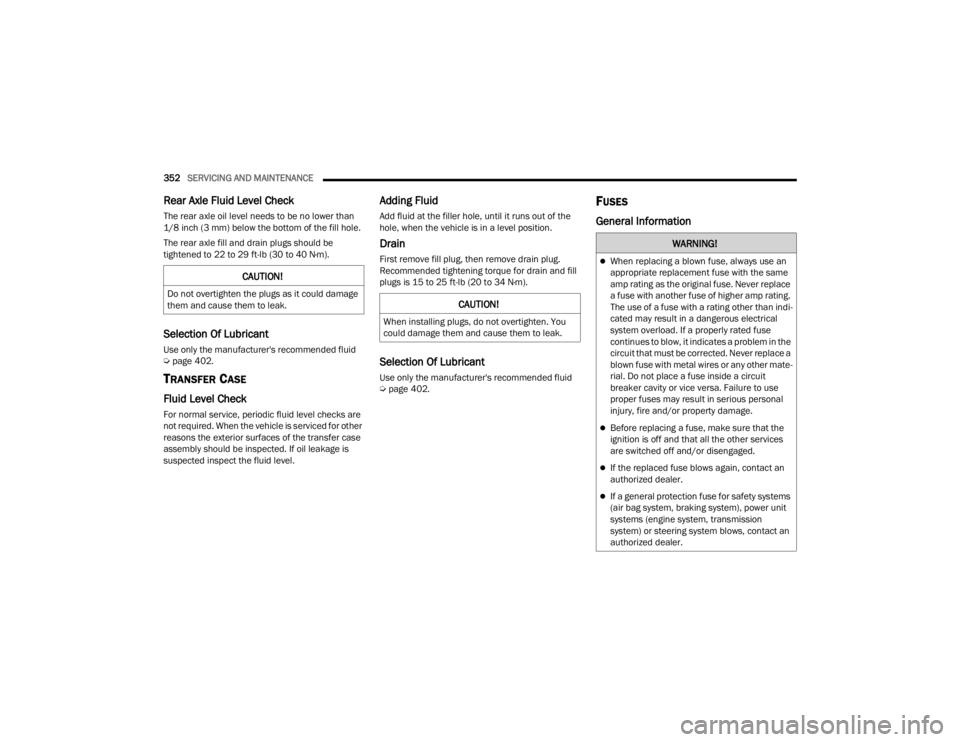
352SERVICING AND MAINTENANCE
Rear Axle Fluid Level Check
The rear axle oil level needs to be no lower than
1/8 inch (3 mm) below the bottom of the fill hole.
The rear axle fill and drain plugs should be
tightened to 22 to 29 ft-lb (30 to 40 N·m).
Selection Of Lubricant
Use only the manufacturer's recommended fluid
Úpage 402.
TRANSFER CASE
Fluid Level Check
For normal service, periodic fluid level checks are
not required. When the vehicle is serviced for other
reasons the exterior surfaces of the transfer case
assembly should be inspected. If oil leakage is
suspected inspect the fluid level.
Adding Fluid
Add fluid at the filler hole, until it runs out of the
hole, when the vehicle is in a level position.
Drain
First remove fill plug, then remove drain plug.
Recommended tightening torque for drain and fill
plugs is 15 to 25 ft-lb (20 to 34 N·m).
Selection Of Lubricant
Use only the manufacturer's recommended fluid
Úpage 402.
FUSES
General Information
CAUTION!
Do not overtighten the plugs as it could damage
them and cause them to leak.CAUTION!
When installing plugs, do not overtighten. You
could damage them and cause them to leak.
WARNING!
When replacing a blown fuse, always use an
appropriate replacement fuse with the same
amp rating as the original fuse. Never replace
a fuse with another fuse of higher amp rating.
The use of a fuse with a rating other than indi -
cated may result in a dangerous electrical
system overload. If a properly rated fuse
continues to blow, it indicates a problem in the
circuit that must be corrected. Never replace a
blown fuse with metal wires or any other mate -
rial. Do not place a fuse inside a circuit
breaker cavity or vice versa. Failure to use
proper fuses may result in serious personal
injury, fire and/or property damage.
Before replacing a fuse, make sure that the
ignition is off and that all the other services
are switched off and/or disengaged.
If the replaced fuse blows again, contact an
authorized dealer.
If a general protection fuse for safety systems
(air bag system, braking system), power unit
systems (engine system, transmission
system) or steering system blows, contact an
authorized dealer.
23_WL_OM_EN_USC_t.book Page 352
Page 355 of 424
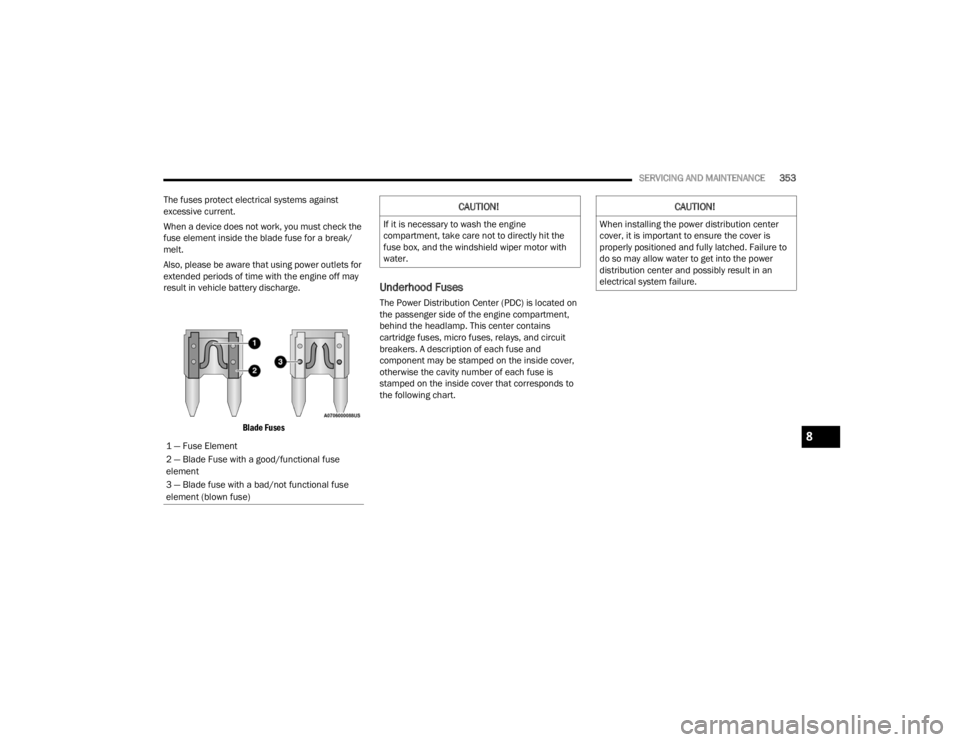
SERVICING AND MAINTENANCE353
The fuses protect electrical systems against
excessive current.
When a device does not work, you must check the
fuse element inside the blade fuse for a break/
melt.
Also, please be aware that using power outlets for
extended periods of time with the engine off may
result in vehicle battery discharge.
Blade Fuses
Underhood Fuses
The Power Distribution Center (PDC) is located on
the passenger side of the engine compartment,
behind the headlamp. This center contains
cartridge fuses, micro fuses, relays, and circuit
breakers. A description of each fuse and
component may be stamped on the inside cover,
otherwise the cavity number of each fuse is
stamped on the inside cover that corresponds to
the following chart.
1 — Fuse Element
2 — Blade Fuse with a good/functional fuse
element
3 — Blade fuse with a bad/not functional fuse
element (blown fuse)
CAUTION!
If it is necessary to wash the engine
compartment, take care not to directly hit the
fuse box, and the windshield wiper motor with
water.
CAUTION!
When installing the power distribution center
cover, it is important to ensure the cover is
properly positioned and fully latched. Failure to
do so may allow water to get into the power
distribution center and possibly result in an
electrical system failure.
8
23_WL_OM_EN_USC_t.book Page 353
Page 356 of 424
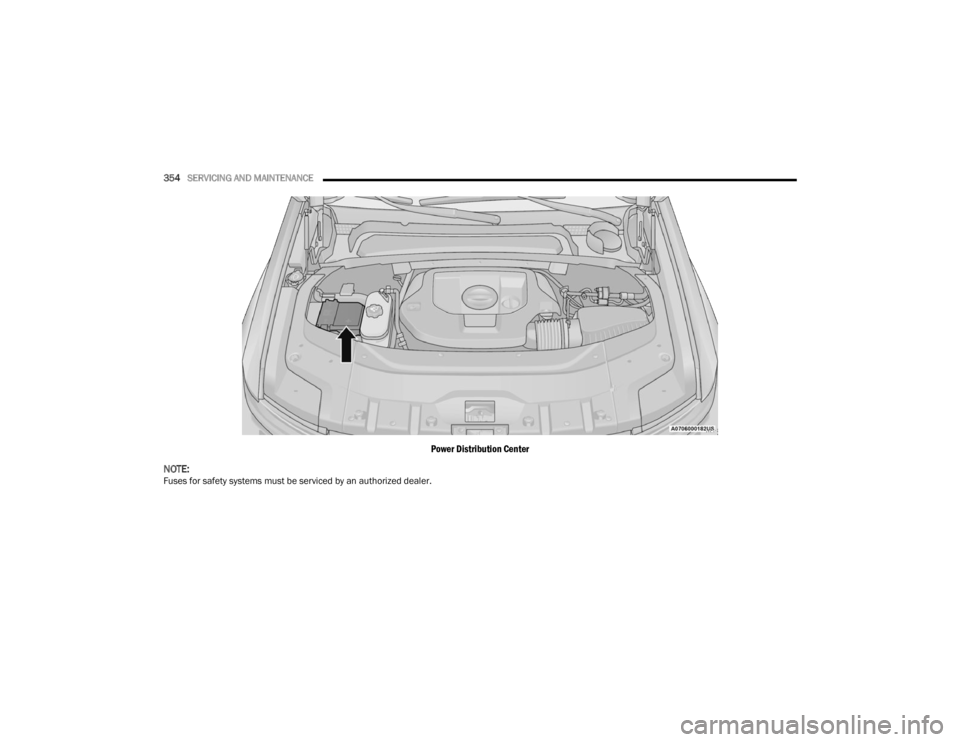
354SERVICING AND MAINTENANCE
Power Distribution Center
NOTE:
Fuses for safety systems must be serviced by an authorized dealer.
23_WL_OM_EN_USC_t.book Page 354
Page 357 of 424
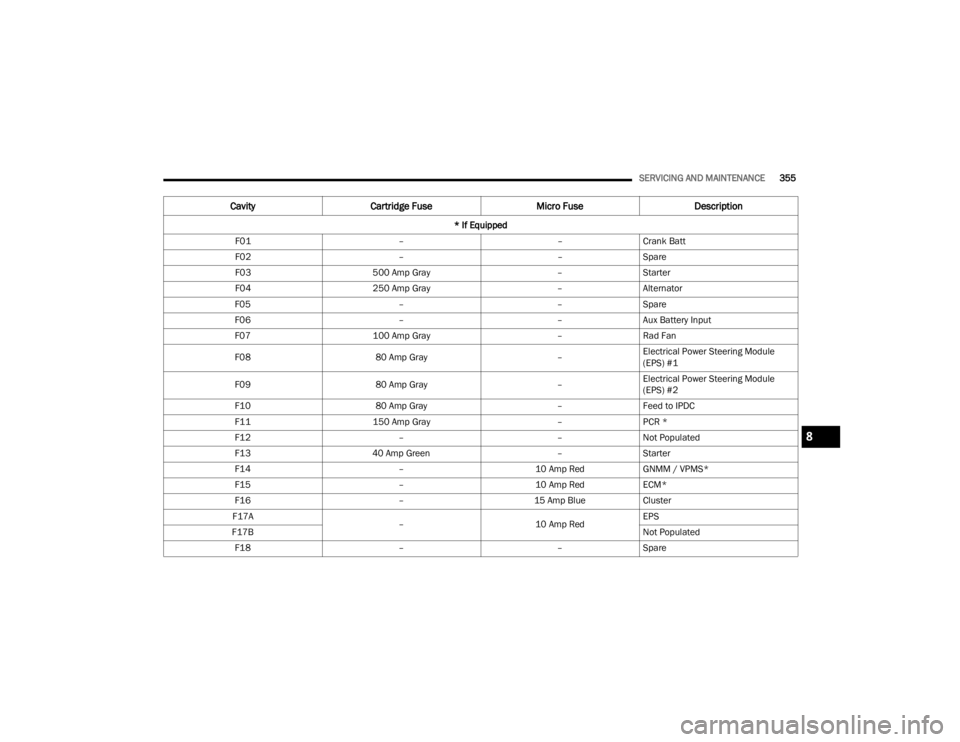
SERVICING AND MAINTENANCE355
CavityCartridge Fuse Micro FuseDescription
* If Equipped
F01 ––Crank Batt
F02 ––Spare
F03 500 Amp Gray –Starter
F04 250 Amp Gray –Alternator
F05 ––Spare
F06 ––Aux Battery Input
F07 100 Amp Gray –Rad Fan
F08 80 Amp Gray –Electrical Power Steering Module
(EPS) #1
F09 80 Amp Gray –Electrical Power Steering Module
(EPS) #2
F10 80 Amp Gray –Feed to IPDC
F11 150 Amp Gray –PCR *
F12 ––Not Populated
F13 40 Amp Green –Starter
F14 –10 Amp RedGNMM / VPMS*
F15 –10 Amp RedECM*
F16 –15 Amp BlueCluster
F17A –10 Amp RedEPS
F17B Not Populated
F18 ––Spare
8
23_WL_OM_EN_USC_t.book Page 355
Page 358 of 424
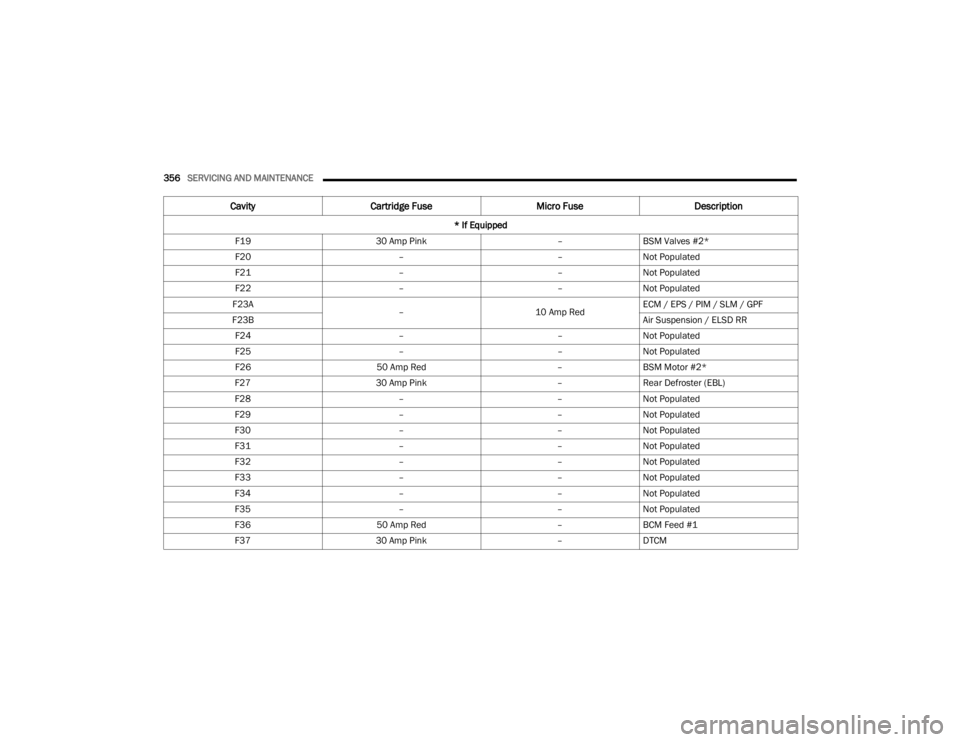
356SERVICING AND MAINTENANCE
F19 30 Amp Pink –BSM Valves #2*
F20 ––Not Populated
F21 ––Not Populated
F22 ––Not Populated
F23A –10 Amp RedECM / EPS / PIM / SLM / GPF
F23B Air Suspension / ELSD RR
F24 ––Not Populated
F25 ––Not Populated
F26 50 Amp Red –BSM Motor #2*
F27 30 Amp Pink –Rear Defroster (EBL)
F28 ––Not Populated
F29 ––Not Populated
F30 ––Not Populated
F31 ––Not Populated
F32 ––Not Populated
F33 ––Not Populated
F34 ––Not Populated
F35 ––Not Populated
F36 50 Amp Red –BCM Feed #1
F37 30 Amp Pink –DTCM
Cavity Cartridge Fuse Micro FuseDescription
* If Equipped
23_WL_OM_EN_USC_t.book Page 356
Page 359 of 424

SERVICING AND MAINTENANCE357
F38 ––Not Populated
F39 ––Not Populated
F40 –5 Amp TanBattery Sensor #1
F41 –20 Amp YellowCADM MAP*
F42 ––Not Populated
F43 –10 Amp RedEngine Control Module (ECM)
F44 ––Not Populated
F45 –15 Amp BlueFront Axle Disconnect
F46 ––Not Populated
F47 ––Not Populated
F48 –10 Amp RedCVPAM
F49 ––Not Populated
F50 ––Not Populated
F51 –20 Amp YellowFuel Pump
F52 ––Not Populated
F53 ––Not Populated
F54 –20 Amp YellowHeadlamp LT
F55 –15 Amp BlueBPCM *
F56 ––Not Populated
F57 ––Not Populated
Cavity Cartridge Fuse Micro FuseDescription
* If Equipped
8
23_WL_OM_EN_USC_t.book Page 357
Page 360 of 424
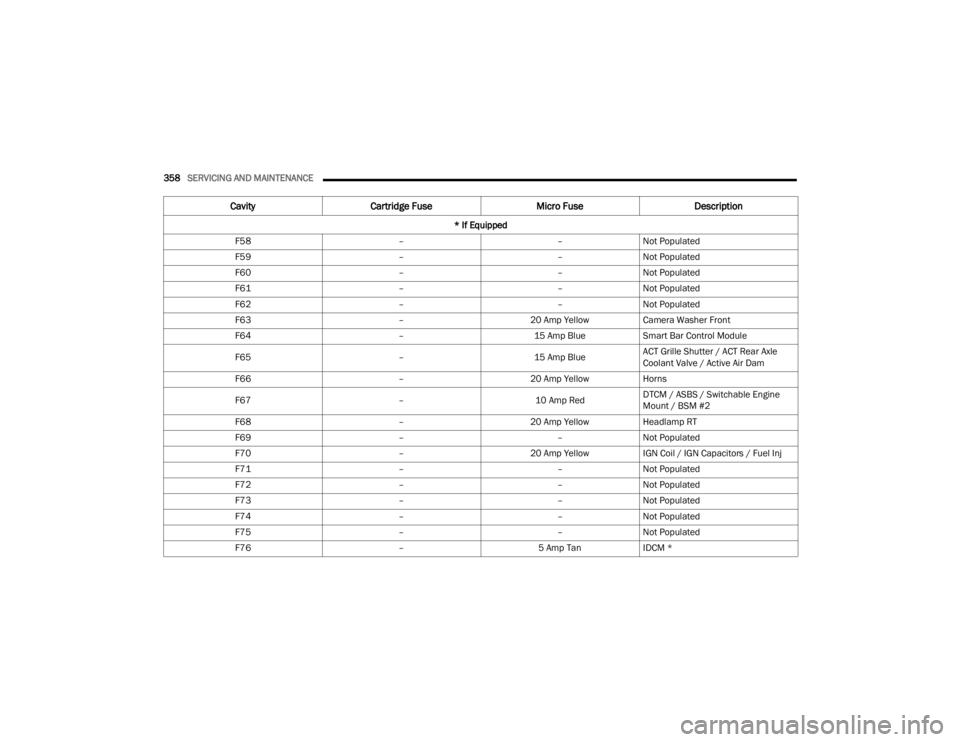
358SERVICING AND MAINTENANCE
F58 ––Not Populated
F59 ––Not Populated
F60 ––Not Populated
F61 ––Not Populated
F62 ––Not Populated
F63 –20 Amp YellowCamera Washer Front
F64 –15 Amp BlueSmart Bar Control Module
F65 –15 Amp BlueACT Grille Shutter / ACT Rear Axle
Coolant Valve / Active Air Dam
F66 –20 Amp YellowHorns
F67 –10 Amp RedDTCM / ASBS / Switchable Engine
Mount / BSM #2
F68 –20 Amp YellowHeadlamp RT
F69 ––Not Populated
F70 –20 Amp YellowIGN Coil / IGN Capacitors / Fuel Inj
F71 ––Not Populated
F72 ––Not Populated
F73 ––Not Populated
F74 ––Not Populated
F75 ––Not Populated
F76 –5 Amp TanIDCM *
Cavity Cartridge Fuse Micro FuseDescription
* If Equipped
23_WL_OM_EN_USC_t.book Page 358